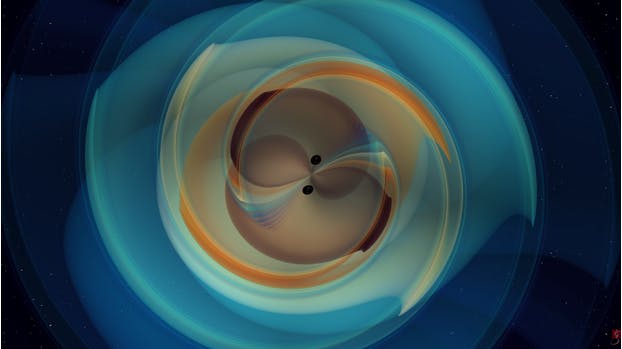
A still image from a numerical simulation of two black holes that inspiral and merge, emitting gravitational waves. (Credit: N. Fischer, H. Pfeiffer, A. Buonanno (Max Planck Institute for Gravitational Physics), Simulating eXtreme Spacetimes (SXS) Collaboration)
UF researchers discovered the first of a new classification of black holes that creates as many questions as answers about the universe.
Their findings, which were published Sept. 2, are described as the missing link between the two known types of black holes, said Imre Bartos, the head of the Bartos group, a collection of UF researchers who focus on exploration of the universe.
This phenomenon, now labeled as an intermediate black hole, was previously only known to be theoretically possible. How this interstellar event occurred is still being uncovered, Bartos said.
A black hole is formed when a star collapses in an area in space under its own gravity, he said.
“We are in the business of finding back holes that collide,” Bartos said. “And there's a variety of them--there's a whole zoo out there in the universe.”
Prior to the birth of the intermediate black hole in May 2019, all of the black holes detected by the Bartos group were as they were expected to be.
The group’s most recent discovery is the first recorded collision of its kind and created a black hole that is distinct in its size and spin, he said.
Bartos said that the two black holes that collided could cover the state of Florida. This massive size indicated that they couldn’t have originated from the collapse of a star, the way that a stellar-mass black hole is created.
The other documented type of black hole is a supermassive black hole, which can be 4 million times the size of our galaxy’s sun, Bartos said. It’s theorized to be created when smaller, stellar-mass black holes collide into one another.
The size of the black hole discovered by the Bartos group did not match this description either.
“While we will have many more events and that will give us an even clearer picture I think we already have a reasonably good understanding of what may be going on during the universe,” Bartos said.
Bartos said that this is only the beginning of a long string of discoveries. What has been a handful of discoveries will be thousands in the next five years or so, Bartos said.
Sergey Klimenko, a UF researcher in the Bartos group, echoed this excitement.
“This is really an awesome new science just emerging in the discovery of this,” he said.
Klimenko explained how difficult it is to detect these kinds of black holes, as well as the collaborative nature that makes discoveries like this possible.
The UF team works closely with the LIGO Gravitational-wave Observatory, which detects gravitational waves from its two locations in Washington and Louisiana. In 2015, The Bartos group created an algorithm for the LIGO instruments that identifies gravitational wave frequencies that have not been recorded before.
Klimenko laughed and said the algorithm took so long to develop that six UF graduate students in their program had come and gone before it was ready to make discoveries like this most recent one.
Klimenko said that the creation of this intermediate black hole took place in 1/10 of a second. Such a brief event could be taken for a blip in the data collected by the LIGO instruments that may have been mistaken as a plane taking off or a train rattling across its tracks. The team’s algorithm was what identified the gravitational waves as extra-terrestrial.
The LIGO detectors are currently undergoing encryption to increase security but will be turned back on in about a year.
“In the future, we hope that detectors will be more sensitive and, more importantly, they will be more sensitive at low frequencies, where these monsters actually live,” Klimenko said.





